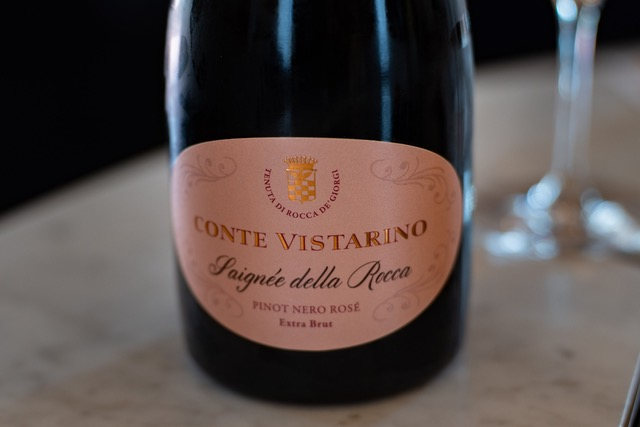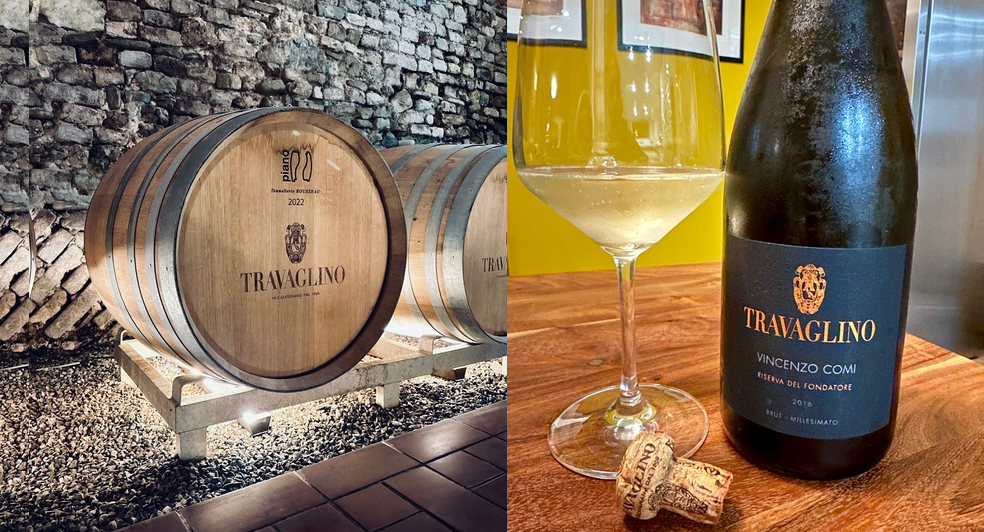The Oltrepò Pavese Wine Region and Its Sparkling Wines
13th February 2024

In the Italian region of Lombardia, the Oltrepò Pavese Metodo Classico DOCG is the officially recognised appellation for the sparkling wine from this area (DOCG, Denominazione di Origine Controllata e Garantita – controlled and guaranteed designation of origin). It is one of the most important sparkling wine appellations of Italy, the others being the Trento DOC in the Trentino region and the Franciacorta DOCG also in the Lombardia region.
The Oltrepò Pavese is a territory that has a history of more than two thousand years and where the gentle hills of vineyards cultivated with Pinot Nero, Barbera, Bonarda, Moscato, Riesling and Croatina have always been part of the landscape.
Viticulture has been practiced in the Oltrepò Pavese region for centuries. The first official evidence of the presence of vines in the Oltrepò can be found in the 1876 document ‘Bollettino del Comizio Agrario Vogherese’, which reports the discovery of a fossilised vine trunk, 25 cm long by 6 cm in diameter, found near Casteggio town (Clastidium). However, the first mention of viticulture in the Oltrepò belongs to Strabo, a Greek historian and geographer who lived between 60 B.C. and 20 A.D. He documented his passage through the region in 40 B.C. and wrote of ‘good wine, hospitable people and very large wooden barrels’.
The first vines were planted during the Roman Empire. It was an attempt to produce wine that could compete with Greek wines, which were the best-known and most desired wines at the time. Another mention of viticulture in the Oltrepò Pavese region is from the ‘Codex Etruscus’ (The Etruscan Codex) from 850 AD. The production of wine became more widespread in the 15th century when it was recognised as an important part of agricultural production.
The name Oltrepò Pavese means the region on ‘the other side’ (the south) of the River Po, the longest river in Italy. Just a little north of the Po River lies the historical city of Pavia (hence Pavese as it belongs to the same province) and a bit further north is Milan. This wine region is located exactly half way between the North Pole and the Equator, namely on the 45th parallel like Bordeaux. Oltrepò wine region is characterised by hills and mountains, making it ideal for the cultivation of grapes.
It extends over an area of 3,600 square kilometers and includes sixteen municipalities.
Vines grow well in a region like Oltrepò with an excellent microclimate, rich soil, and a terroir similar to that of the Langhe in the Piedmont region. Oltrepò produces more than half of the wine from the Lombardy region.
The soils of the Oltrepò Pavese wine region are composed of ancient rocks called Terra Rossa. These rocks provide the Oltrepò Pavese region with rich humus and clay for their vines to grow. The soils also contain a large amount of iron, which magnifies the red/black colour of the wine grapes. The climate in this region is typical of the Mediterranean climate found close to the Alps. The region has warm summers and mild winters with little rain, making it suitable for Mediterranean viticulture.
The Oltrepò is often neglected by tourists and wine lovers in favour of locations such as Tuscany and, as a result, is quiet, beautiful and authentic.
In the last 150 years, the Oltrepò has grown to become one of the largest wine-producing areas of Italy. Sparkling wine is still the region’s flagship but many other types of wine are produced as well. Oltrepò accounts for 65% of the wine production in the Lombardy region and is Italy’s largest producer of Pinot noir (75% of Italian Pinot Noir comes from Oltrepò), with approximately 3,000 hectares planted to the variety, out of a total of 13,000 hectares cultivated to vines in Oltrepò. It is also the world’s third largest producer of the variety after Bourgogne and Champagne.
I recently tasted these sparkling wines from Oltrepò Pavese:
1. Saignée della Rocca Metodo Classico Brut by Conte Vistarino winery, 100% Pinot Noir – Disgorgement: February 2022.

Conte Vistarino is an historic winery in the Oltrepò Pavese wine region which I visited in 2022. The Giorgi di Vistarino Family has owned the estate since the mid-15th century with the current generation represented by Countess Ottavia Giorgi di Vistarino.
More than 150 years ago, Count Augusto Giorgi di Vistarino realised that the terroir of the region would be ideal for Pinot Noir. The count decided to import the vine and the first spumante (sparkling wine) of the Oltrepò was produced in 1865.
‘Saignée della Rocca Metodo Classico Brut’ showed a pale pink colour with fine and persistent effervescence. On the nose, it elegantly expressed aromas of small red berries, dried rose petals, grapefruit, rosehip and apricot. Pretty dry on the palate with a very defined fruit presence. Medium richness and weight accompanied by excellent freshness and sapidity. Clean, elegant and silky long finish.
2. Maria Cristina Pas Dosé Rosé 2016 by Cantine I Gessi, Defilippi Winery, 100% Pinot Noir.

The Defilippi – I Gessi winery, owned by the Defilippy family, was founded in the village of Oliva Gessi more than a century ago, in 1907. This winery owns a total of 45 hectares of vineyards. Today, the management of the vineyards and the vinification take place according to the most modern technologies, with full respect for the environment and tradition.
The family, now in its fifth generation with Federico and Alessandro, is the beating heart of the company. Tradition and passion, qualities that have always distinguished the family, are fully transmitted by Emilio and Fabio who, thanks to their long experience, control and coordinate all operations, from the vineyards to the cellar.
Oliva Gessi is a village, located on the green hills of Oltrepò Pavese, between Casteggio and Montalto Pavese towns. The clayey and calcareous soil and the particular climate make the cultivation and production of noble varieties, such as Rhyne Riesling and Pinot Noir, optimal.
‘Maria Cristina Pas Dosé Rosé 2016’ was disgorged in May 2021 and aged on lees for 65 months. Only 1,500 bottles of this wine were produced. It showed a pale pink colour and expressed a high level of complexity on the nose, with pronounced aromas of apricot, mandarin orange, red currant, wild strawberry, fresh croissant, also a light balsamic hint combined with floral notes of rose, white wisteria and iris. On the palate it was elegant, and creamy, providing a sense of fullness and flavours of raspberry, cherry and red peaches, ending with a wonderful very long mineral finish.
3. Vincenzo Comi Riserva del Fondatore Brut 2016 by Travaglino Winery, 100% Pinot Noir – Disgorgement: June 2022. 3,000 bottles produced.

Travaglino is the oldest winery in the Oltrepò Pavese and is located in the commune of Calvignano. In medieval times the estate was a monastery and in the nineteenth century became a winegrowing estate. The first certain mention of the Estate dates back to November 1111. In the 17th and 18th centuries, Villa Travaglino was transformed into the current complex comprising an extensive courtyard, the oratory and farm workers’ houses. In 1868, Vincenzo Comi from Milan purchased the Villa and around 53 hectares of surrounding land which would become the first part of the Travaglino Estate.
In 2013, the fifth generation of winemakers, Cristina and Alessandro Cerri Comi, Vincenzo’s grandchildren, joined the estate. They focused their work on quality and on rationalising the winery’s work, which is concentrated on the Estate’s two main varieties: Pinot Noir, in its different nuances, and Rhine Riesling.
Nowadays, Travaglino cultivates more than 80 hectares of vineyards.
‘Vincenzo Comi Riserva del Fondatore Brut 2016’ is a complex wine due to the quite long ageing period on lees (60 months). On the nose, it initially exhibited delicate aromas of white blossom (elderflower), ripe lemon, hazelnut and stone fruit. These aromas were followed by notes of melted butter, bread crust and minerality. On the palate, it showed an excellent structure and a pleasant acidity. It was silky with mineral and fruity notes (quince) and a long finish. It is an outstanding wine that will likely benefit and improve with spending more time in the cellar.
By Marco Alessandro Felicissimo
Instagram: @marco_felicissimo_sommelier
Photos by Marco Alessandro Felicissimo
![]()
Marco Alessandro Felicissimo
Italian wine writer and blogger who has a sheer passion for wine. He loves travelling to wine regions all over the world to learn as much as possible and sharing his humble knowledge about the wine world
